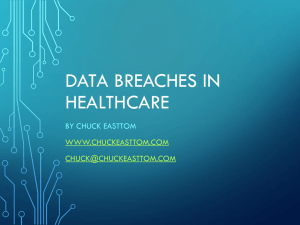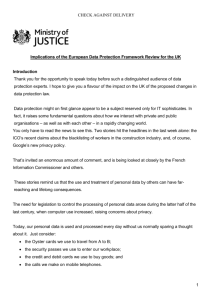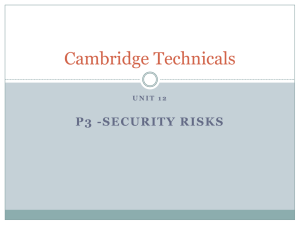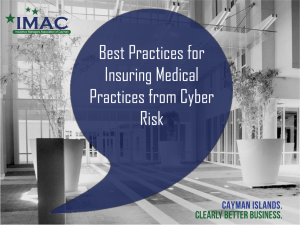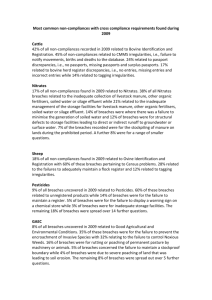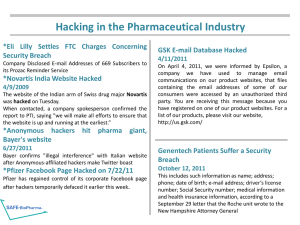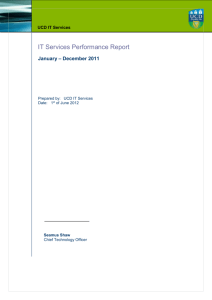here - Health Research Authority
advertisement
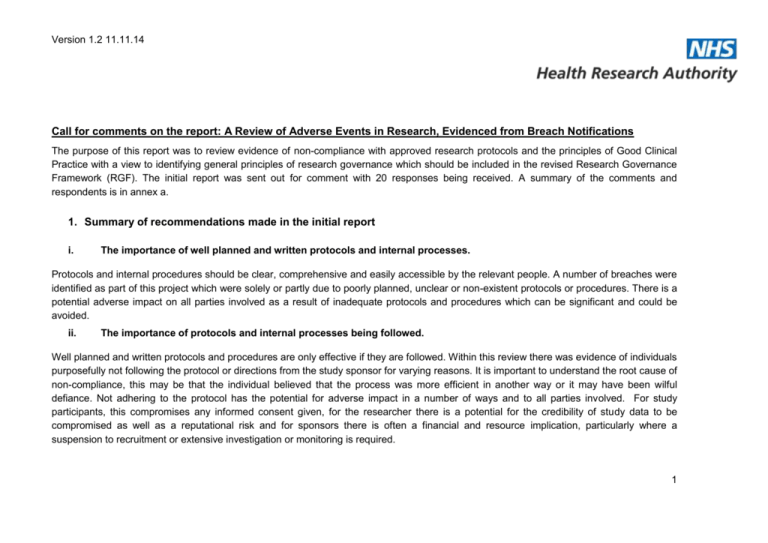
Version 1.2 11.11.14 Call for comments on the report: A Review of Adverse Events in Research, Evidenced from Breach Notifications The purpose of this report was to review evidence of non-compliance with approved research protocols and the principles of Good Clinical Practice with a view to identifying general principles of research governance which should be included in the revised Research Governance Framework (RGF). The initial report was sent out for comment with 20 responses being received. A summary of the comments and respondents is in annex a. 1. Summary of recommendations made in the initial report i. The importance of well planned and written protocols and internal processes. Protocols and internal procedures should be clear, comprehensive and easily accessible by the relevant people. A number of breaches were identified as part of this project which were solely or partly due to poorly planned, unclear or non-existent protocols or procedures. There is a potential adverse impact on all parties involved as a result of inadequate protocols and procedures which can be significant and could be avoided. ii. The importance of protocols and internal processes being followed. Well planned and written protocols and procedures are only effective if they are followed. Within this review there was evidence of individuals purposefully not following the protocol or directions from the study sponsor for varying reasons. It is important to understand the root cause of non-compliance, this may be that the individual believed that the process was more efficient in another way or it may have been wilful defiance. Not adhering to the protocol has the potential for adverse impact in a number of ways and to all parties involved. For study participants, this compromises any informed consent given, for the researcher there is a potential for the credibility of study data to be compromised as well as a reputational risk and for sponsors there is often a financial and resource implication, particularly where a suspension to recruitment or extensive investigation or monitoring is required. 1 Version 1.2 11.11.14 iii. The importance of good communication processes and lines of responsibility. A number of breaches were identified as having occurred due to communication not happening or from being ineffective and from a lack of clarity regarding responsibility. There should be clear designation of responsibility and accountability with clear lines of communication between all those involved in research. Communication pathways should be clear in terms of what, how, who, when and why with documented roles and responsibilities. iv. The importance of document management systems or good version control There is often a requirement for documents to be revised and updated during the lifespan of studies and these requirements are often initiated by varying organisations. It is therefore important to ensure that the competent authority and ethics committee have reviewed and approved the most current version and that all those involved in undertaking research procedures are aware of the most current and approved version. Good document control for all is essential and needs improvement. v. The need to ensure learning rather than just delivering training Corrective and preventative action plans commonly cited training and re-training of members of the research time. This was often in relation to standard study procedures. It is however important to understand the root cause of non-compliance and having a more targeted approach rather than defaulting to providing training. Non-compliance may be due to not knowing the correct procedure, misunderstanding the correct procedure or wilful deviation, which may be due to poorly planned or unrealistic procedures. The targeted approach would differ depending on the root cause. It is important to ensure that members of the research team are aware of the correct procedure but also that they fully understand what this requires and the importance of following it and that understanding and compliance is confirmed. It is also important to understand the wider context of error. If an individual makes an error due to insufficient time to complete a number of tasks, providing training will not in itself solve the problem or reduce the risk of the error being repeated. vi. The importance of encouraging open and honest reporting It is widely recognised in healthcare that a culture of openness and honesty promotes safety. In clinical practice, incident reporting is strongly encouraged so that lessons can be learnt and improvements made. This principle is equally as valid in research both clinical and non-clinical. Errors can only be rectified and improvements made to reduce adverse impacts and increase the quality of research outcomes if they are reported in a timely way. For this to be truly effective, a culture of openness and honesty is essential with a focus on improvement rather than consequence. 2 Version 1.2 11.11.14 2. Responses received from call for comments external to the HRA. The following comments were received from external stakeholders and will be given due consideration by the HRA in regard to the revision of the Research Governance Framework. General support for the recommendations. The responses indicated a general support for the recommendations made within the report. Where there is no regulation, there is a risk that quality will slip. Some respondents made reference to there being a reduction in quality assurance processes for non CTIMPs due to regulatory requirements and also by non commercial sponsors. This was particularly in regard to there being a focus on meeting the regulatory requirements of the MHRA. However, with regulation also comes a cost and resource implication, both in terms of meeting the regulatory requirements and also to be able to demonstrate compliance, which should be given consideration. Increasing resource pressures may have the consequence of preventing important research as it becomes unaffordable. A risk based approach to regulation and monitoring may be most appropriate for non CTIMPs to ensure that resources are being used effectively and efficiently. Need for clearly defined responsibilities covering all roles and responsibilities within research. Some responses called for greater clarity in regard to responsibility, both for individuals taking on these roles and also for the benefit of all members of the research team. There was a particular request for improved study team structures which facilitate good communication between research teams and sponsors and also ensure that PIs communicate study details to colleagues who are not directly involved to reduce inadvertent protocol deviations and breaches. There was also call for clearly defined responsibilities of individual sites. The current RGF does define key responsibilities which is welcomed and further review of these responsibilities within the revised document would be valuable. 3 Version 1.2 11.11.14 Lack of awareness regarding requirements for reporting of non CTIMP serious breaches as not covered by the CT regulation. The requirements for reporting serious breaches in non CTIMPs is set out in the NRES Standard Operating Procedures. However, this assumes that sponsors and researchers are familiar will this section within this document which is unlikely to always be the case. The knowledge of the existence of this documents and the knowledge of its content is likely to vary significantly between organisations and even within organisations. Moreover, it is not clear what weight the NRES SOPs have in regard to non CTIMPs which is particularly relevant when the onus is on the sponsor or researcher to inform, notify or report to the REC. Greater clarification regarding policy and regulation would be welcomed, particularly when there is consequence for non compliance. Difference in ways of working between commercial and non commercial sponsors, including in regard to audit and monitoring of ongoing studies. Need for greater support for non commercial sponsors. Reference was made to a toolkit being developed to support non commercial sponsors, particularly the less research active higher education institutions who may feel isolated and unsupported. Support may also be provided by developing relationships and awareness of what guidance and support is available. There may be good practice examples of such relationships across the UK which could be used to develop a system of closer working relationships. This may help to develop a more consistent approach to the management of research. Guidance regarding training and learning requirements, including ensuring understanding, would be welcomed. It was reiterated by some respondents that there needs to be a balance between training and learning. GCP training was quoted as being “variable and, sometimes, uninspiring; resulting in attendance, rather than learning”. There was also reference to some commercial companies insisting that their own GCP training is undertaken which may result in multiple GCP courses within a short period of time. The approach to training and learning would be more effective if goal driven rather than process driven or there may be a risk of mandatory GCP training being counterproductive, i.e attendance rather than learning. 4 Version 1.2 11.11.14 Suggestion that monitoring requirements should be lessened as it has a significant resource implication and also the level of commercial monitoring is unnecessarily excessive. There was one suggestion that monitoring and oversight of research should be lessened and that researchers should be relied on to manage protocol deviations and breaches themselves without the need to report them. This suggestion came from the only researcher response received and possibly indicates differing views between sponsor and researchers in regard to research governance. Lessening monitoring and reporting requirements would undoubtedly limit shared learning and would be counterproductive in regard to promoting communication between research teams and sponsors. It may be more effective to promote monitoring and reporting processes as supportive for research teams and important for organisational learning and development rather than unnecessarily burdensome or overly bureaucratic. Consider including non serious breach reporting in standard reporting processes. RECs may also be well placed to facilitate the sharing of learning as part of their role. The REC, and the HRA more generally, are well placed to support research applicants based on their experience. This may be particularly beneficial for research applicants who come from institutions which are not very research active, particularly in regard to healthcare related research. Standard reporting of non serious breaches, possibly as part of the annual reporting process, would mean that a more comprehensive picture of research governance could be developed by the REC and also the HRA. This could in turn help to improve the support, guidance and advice provided. Consideration would however need to be given to the impact which additional reporting would have and also how this requirement would be governed. Balancing clinician autonomy and following approved protocols. It was noted that researchers are often practicing clinicians who follow standard clinical care pathways. Research protocols which deviate in any way from standard clinical care are therefore at risk of inadvertent breaches. This is something that should be given due consideration as a possible root cause of protocol deviations so that systems and processes can be designed accordingly. Increased use of electronic systems rather than paper based systems, including direct electronic reporting. Systems are increasingly becoming electronic based and there are significant benefits to this, as well as certain risks. Electronic systems create a good audit trail, information can be shared more quickly and allow for remote monitoring, which can significantly save time and 5 Version 1.2 11.11.14 resources. The REC system currently accepts some but not all correspondence directly through the IRAS / HRA Application Review Portal (HARP) interface. Expanding this functionality to include all REC reporting would make the process quicker and easier. Moreover, electronic systems within organisations undertaking research Responses suggest there is still a culture of blame when errors occur. This is not conducive to an open reporting culture. The message needs to be clear that reporting of breaches which have occurred is a positive thing and is imperative to ensure research is effective, efficient and safe. However, not only does the message need to be clear, it needs to be evident in practice to create a true ‘no blame’ culture. Improved document control systems would save time and improve efficiency All healthcare related research requires documentation which is version controlled, whether this is the study protocol, participant information sheets, consent forms etc. Effective version control systems and processes are important to ensure that the correct, most up to date, approved documentation is being used or followed by all members of the research team. It is also important to be mindful that documents cannot be controlled when printed so the latest version should be easily identifiable on an electronic system and, where possible, printed when required. Need to fully understand the (often) complex reasons that breaches occur. Breaches are commonly the result of a number of influencing factors. For example, when looking at the practice of an individual, it is important to also look at the wider environmental factors which may have influenced actions. By undertaking root cause analysis when breaches do occur, this will ensure that appropriate and effective corrective and preventative action can be taken rather than addressing a superficial problem which would then be likely to recur. Simple and clear definition of terms and consistency of terminology across all relevant organisations. 6 Version 1.2 11.11.14 The different terminology used within different organisations was noted and even different interpretations of words within commonly used acronyms. Organisations, such as the MHRA and HRA, working closely together should ensure consistency of language to ensure clarity and reduce the risk of confusion or misinterpretation. Such consistency of language should be used throughout the revised RGF. Need to ensure quality at the point of initial submission. Too many applications are submitted too early with poorly written protocols which results in a requirement for substantial amendments which could have been avoided with better forethought. By sharing experience through a co-ordinated approach to provided early advice and support and ensuring that research applicants who need additional support are reached, the quality of research applications could be improved. Proposals: 1. Consider inclusion of the principles identified above within the revised RGF. 2. Consider the degree of ‘regulation’ that may be required for non CTIMP research to increase parity and whether a risk based approach would be appropriate; taking into consideration resource limitations and the impact which this might have. 3. Undertake a review of language being used across relevant organisations to ensure consistency. 4. Explore the role of the REC/REC service in providing co-ordinated pre application support and advice with the aim of improving the quality of research applications at the point of submission. 7 Version 1.2 11.11.14 Risk in Research Comments Summary Comment Provided Oxford University 1. The development, by the HRA, of recommended protocol templates is welcome, especially if the result is a greater focus on the content of the protocol, rather than that of the IRAS form. 2. Another point of note is the prevalence of substantial amendments to the protocol and other documentation. This is not only time and resource consuming, at an organisational level, but exposes researchers to confusion, increasing the risk of non-compliance and breaches. It is well recognised that many amendments are due to poor planning and quality assurance, during protocol development. 3. Where SOPs are in place, they should be appropriate and fit for purpose; be regularly reviewed and updated; easily accessible; and, of course, followed. They should be viewed by research teams as an essential tool to ensure quality and consistency in the conduct of the research. 4. Familiarity with a trial or research study could mean that the protocol is referred to less and less over the lifetime of the study; thus resulting in protocol violations, through a loss of accurate recall of the details; for example the precise details of eligibility criteria. 5. During preparation of a research application, much attention is given to the content of all of the documentation: the arrangements for data protection; the process for approaching participants; the information delivered and checked during the consent process etc. However, the perfection of the documents submitted is irrelevant unless the high quality is reflected in the study conduct, rather than following a path of convenience. 6. The majority of researchers are also practicing clinicians, with patients following a normal care pathway. It could be easy, therefore, for a study which closely resembles this pathway, to become confused with it. 7. . Whilst adherence to the eligibility criteria is usually closely monitored in a commercially sponsored trial, with prompt correction of breaches, this is not necessarily the case for non-commercial trials and other categories of research. The cause of this would not necessarily be due to inattention. As indicated above, clinicians are used to making decisions for the initiation of treatment of their patients, based on a much wider range of criteria and can sometimes forget that their wider knowledge and judgement should not be applied in the case of enrolment into a research study. 8. For non-CTIMPs, the existence of even the documentation of delegation can be overlooked. This reflects many other points in this feedback, where the need for good practice is overlooked, if there is no regulatory requirement. 9. As is evidenced by your paper, there is a clear need for those involved in the conduct of clinical research to be trained for their role. However, there has arisen an obsession with the need for ‘GCP training’. The content of training carrying this label is variable and, sometimes, uninspiring; resulting 8 Version 1.2 11.11.14 10. 11. 12. 13. 14. 1. 2. 3. 1. in attendance, rather than learning. The situation is complicated by the fact that commercial companies have become so concerned to ensure that they will satisfy the MHRA, during inspections, that they will insist on research teams completing their own version of GCP training (often even more uninspiring); regardless of whether the team has already had sufficient training. We have experience of companies requiring research teams, who have already undertaken this specific training for one trial, to retake the training again for a subsequent trial within a year. Within any revision of the Research Governance Framework, it would be of great benefit if the situation was clarified that it is the specific responsibility of the host organisation (i.e. the site) to ensure that its staff are appropriately trained. In addition to this, those organisations should be required to ensure that such training is appropriate to the role of the staff member and the type of research in which they are involved. The low rate of reporting of breaches for non-CTIMPs is likely to be through a lack of awareness of this requirement, rather than through the research being well managed. Again, this is due to an acute awareness of the regulatory requirement for CTIMPs, resulting in a neglect of other national requirements. There may also be under-reporting on CTIMPs, due to the anxiety, suggested within the paper, that reporting a breach will result in a triggered inspection. Rather the reporting of a breach, for any type of research should be seen as evidence that there is rigorous and confident oversight of the quality of research in that organisation. Breaches are also a valuable tool to prompt assessment of weaknesses and implementation of corrective improvements. Publication of this paper and awareness that HRA has oversight may mean that more are reported, as long as the HRA takes the same approach as the MHRA and deals with such reports in a calm and consistent manner. The need for any breaches to be formally closed out, once a satisfactory corrective and preventative action plan has been articulated. This is particularly important in the light for the medical revalidation process, where any outstanding concerns re a PI’s research may be considered as an unresolved complaint. Barnet and Chase Farm Hospital NHS Trust Breaches document makes too much of 6000 studies a year approved – its how many multicentre CTIMPs studies are approved is important. Also given the lack of breaches to low risk studies which are often registries and surveys – there should be a much greater support to enable low risk studies quickly and with a leaner research checks process. Most observational and secondary data use studies should have chairman’s or small committee action rather than require an extensive REC consideration. The breaches declared are appropriate but in a self reported survey it’s the size of the worrisome signals that matters. So breaches such as trial started before approvals should be somewhat checked as to whether these were high risk CTIMPs or less risk already known drugs for different indication etc. Norfolk and Suffolk NHS Foundation Trust Going forward, I feel it is critical that the recommendations make it absolutely explicit about who is responsible for which elements of breach notification. Many of the breach findings in this report, particularly those involving Informed Consent, are unsurprising, with my experience as it is unclear to research teams (and NHS organisations) exactly who was responsible for procedures – sending out new versions of documents being the classic example of “I presumed xxxx would have done that so I didn’t bother!” 9 Version 1.2 11.11.14 2. Adding to the confusion for research teams is lack of commonality of practice of sponsors – Commercial and Non-Commercial (particularly academic) sponsors work in vastly different ways, with varying degrees of oversight and understanding of sponsor responsibilities. For research team members juggling 3 or more studies, which is common in the CRN delivery staff model, the different and inconsistent requirements and practice displayed by sponsors leads to poor practice on an accidental level. Commercial sponsors ensure that all research teams receive updated documentation and practice guidelines, non-commercial sponsors rarely do this. Very few non-commercial sponsors (again, particularly HEIs) perform any kind of auditing and monitoring functions, even on studies which are relatively high risk (non-drug interventions or vulnerable adult populations for example) – this Trust is not alone in conducting these sponsorship-level duties, not through formal agreement, but because we are the only organisations who will, and knowing it is the right thing to do to ensure protection of our service users and staff. I have been involved in discussions about potentially developing a Sponsor practice toolkit, and frankly, I do feel this is essential for research today. 3. I also agree that ensuring learning rather than training is essential for research team members – and this goes beyond delivery staff into chief investigators and other team members. Part of our auditing and monitoring system is to interview research staff about their understanding of procedures and reporting, and we also ask these specific questions in self-audit forms completed annually, but maybe there are better ways to accomplish this. It will be interesting to see any practice guidance coming out of this, because I do agree it is critical. Trust unknown 1. To make the point that Excess treatment costs tend not at all to be covered by CCGs, who have much else to worry about. An alternative payment mechanism is urgently required. It is a major barrier. 2. In addition I think monitoring requirements should be lightened- we do not have the resource to achieve them to Pharma standard [which is often excessive and disproportionate - after all the patients are being carried for by doctors and nurses!] School of Health & Education Middlesex University 1. The recommendations focus upon some extremely important areas of risk and governance in relation to maintaining effective ethical practice. The report has focused upon real examples where there have been changes or incidents in practice. Factors such as Time (for example lack of time, short-cuts in practice / procedure) and resources (for example human and material) would seem to be important in considering the potential for a beneficial outcome. Perhaps these factors should be considered in more depth and highlighted in reqular reporting. The approach to risk reporting might also be considered in a less deficit / blame orientation and more in terms of practice learning examples of error reporting (the concept of work based learning might also be considered in place of 'delivered training'). If a more open and honest culture is to be fostered, there needs to be greater potential for sharing good practice in the preparation of written protocols, clarity in ethics application and methods of regular reporting. The culture of error reporting might be refocused in some way towards learning development opportunity. RECs might include more of a learning development function in order to foster best practice and would need to be appropriately resourced. Imperial College London 1. Provide examples where the investigator can make sensible decisions that enhance the research and patient experience that do not constitute a breach. This would show that there is an element of autonomy in the process and the need to retain personal responsibility. Or is the researcher truly in a straightjacket? Might as well be honest if they are. 10 Version 1.2 11.11.14 2. 97 responses out of how many requests? This seems a rather poor response rate as I imagine between primary, secondary and mental healthcare there may be many hundreds of potential sponsors. If so, this undermines the value of the document as we do not know who has responded and what their motive was? 3. Having just completed my on-line GCP training this year, I recall that one piece of advice was to investigate sites that were reporting few SAEs rather than many. Accordingly, it is not at all reassuring that a low number of breaches were reported. Either people aren’t looking or they are dealing with them in a sensible manner and quietly fixing them without reporting. Maybe this is the best approach as it saves time and effort and prevents resources being squandered on things that will be of low value. 4. It strikes me that many of the errors are related to transcription and communication. Perhaps a major problem is the need to record things in a paper record – which may be increasingly voluminous in patients with chronic disease. Electronic systems, with suitable safeguards, could eliminate most of these. Should investigators be discouraged from creating/retaining any sort of paper record? Electronic systems are more secure, easier to interrogate and can have internal safety checks to prevent error. A shared trial record that was accessible to clinical teams could get rid of most problems. 5. Re-consent with respect to safety issues; I have taken this issue to ethics on at least two occasions as I believed that the sponsors request for reconsent of some patients was inappropriate and, by the standards set out in this document, unethical. 6. In summary, if a strategy of mandatory electronic records was developed, I believe that this would prevent 70% of your breaches and identify most others. Probably, as the system improves, this will greatly increase the number of breaches due to better reporting. NIHR GSTFT/KCL Biomedical Research Centre 1. Separate serious breaches from others? 2. There is little Non CTIMP monitoring so separation of CTIMP and non CTIMP would be beneficial? 3. Non CTIMP adverse event as not subject to the regulation so there is little understanding of how and what to report and how to review these at site or by the sponsor? BSMHFT 1. Version control is a bit issue for us, so clarification on this in the new document will be crucial. Two points on this: - I think researchers should NOT be permitted to submit an amendment until both REC and R&D approval are given - CSP does NOT help with version control, it has become a dumping ground for all docs – the software should be developed to assist version control 11 Version 1.2 11.11.14 2. Open and honest reporting should be encouraged - sometimes researchers are embarrassed when things go wrong and they feel it was their ‘fault’. We need to work on this. 3. The recommendations are accepted in full ABMU Health Board 1. We fully support all recommendations listed. 2. From our local experience, common monitoring findings are centred on insufficient detail in patient notes, missing timescales to report. We aim to inform research teams during initiation and monitoring visits of the various requirements. We echo the recommendation of the need for robust, well-defined research protocols and trial management structures built around the study to facilitate good communication between study team and Sponsor. 3. We also suggest the importance of leadership roles from local PIs, this is really important to engage wider clinical colleagues and ensure staff members not directly involved in the study become familiar with the study requirements. Some local breaches have arisen due to inadvertent protocol deviation due to out of hours staff not being aware of the study and the specific patient requirements within the study. PIs have a role to deliver information about the study to wider colleagues during clinical MDT meetings, this is essential for interventional clinical research. REC Chair - London South East 1. On the rare occasion that our Coordinator alerts the Committee to a serious breach notifications and safety reporting, it is invariably weeks or months after the event, certainly far too late for the REC to take any useful action (assuming we knew what to do). I recall seeing a data breach, and that required a protocol amendment which would have been seen anyway. I find it hard to see what added value there is in RECS having sight of these reports, in contrast to communication to and action by R &D offices. The Dudley Group NHS FT 1. Should there be a requirement for RECs to review the case report forms/ electronic data capture systems used in a study? In a cancer study we were running as a participant site the frequency of CT scans dropped after 48 weeks from 6 weekly to 12 weekly. The online data capture tool had no reminders, possibly due to the fact that no one expected the subjects to receive the drug for so long a period without progression. The sponsoring company did not notice the error. It was a member of staff reading the protocol in preparation for recruiting a patient who picked up on the mistake. 12 Version 1.2 11.11.14 As it happened, the subject was actually annoyed that the number of scans was reduced (subject was terminally ill) but the protocol and data collection tools did not provide visually helpful reminders and were still requesting CT results after the 48 week period had elapsed. 3 non required CT scans were made. Wellcome Trust 1. A colleague and I have reviewed these and think the recommendations look sensible. Salford Royal NHS Foundation Trust 1. I would whole heartedly support the recommendation outlined regarding reporting of breaches and safety reporting- My only further comment would be to ensure that there is full and proper consideration of the complexities of why breaches and non-compliances happen- These are usually complex. Within our organisation we often use root cause analysis to understand these and also conduct regular reviews of ALL issues to establish commonalities. These are then considered and relevant measure put in place which may include changing processes, procedures or implementing training- We review on a 6 monthly basis as well responding to each individual event. York Teaching Hospital 1. Outcomes not of surprise and like to think that they are already complying with the recommendations 2. I suspect that the HRA's challenge will be how to translate the recommendations into specific advice / action that will enable researchers and others to improve their practice so that tangible benefit can be demonstrated. 3. It was confusing that 'protocol violations' were referred to as these would not normally be included in either annual progress reports to RECs or serious breach notifications to the MHRA (unless lots of systematic breaches had led to a serious breach). It was unclear therefore whether i) protocol violations had been reported in their own right by sponsors / CIs ii) Some sponsors or CIs had reported a 'serious' breach which the REC had subsequently decided was actually a protocol violation rather than a serious breach i.e. the REC did not agree with the sponsor's assessment iii) the protocol violations that were mentioned in the report were the breaches that had together led to a serious breach / breaches 4. With regard to alleged cases of fraud and misconduct, we follow the UK Research Integrity Office suggested procedure and would not expect to report 'alleged ' cases to the relevant REC / MHRA. We would only report if an allegation was found to be proven. 5. We were also not entirely sure whether the analysis of root causes was based on actual information supplied to the RECs / MHRA, or whether this was a consideration of possible causes. Equally, regarding the section about impact, was this based on information on actual impact or an assessment of what the potential impact might be. University of Cumbria I have no comments to make other than it read well and covers the aspects required Central Manchester Foundation NHS Trust The recommendations are all practical and should be in place in any research active organisation. The issue may be more around compliance and individuals engagement in these actions –which is more difficult to ensure. UCL 13 Version 1.2 11.11.14 The recommendations section is good but perhaps more guidance might help for example the trial protocol might be based on the SPIRIT guidelines. Sheffield Teaching Hospital • Impact of breaches on page 15 – it is noted that there is reference to ‘actual harm’ however it would be useful going forward to also reference patient safety and rights. • Diagrams on page 17 and 18 are duplicated • What was the split for commercially sponsored and non-commercially sponsored trials? • Were breaches reported by the commercial sponsor or site in question? • Has the recent categorisation of notifiable and non-notifiable amendments in NIHR CSP had any impact on the number of breaches reported in relation to implementation of amendments? • Were there any examples of breaches in imaging as this is often an area of concern in understanding what is normal clinical exposure and what is additional exposure? • Reference is made in the report to breaches (Including serious breaches) and protocol violations, however GCP (the Grey Guide) now uses the terminology non-compliance. It would be useful to have some consistency in terms • What alignment is there with UKRIO procedures? R&D forum 1. It is suggested that a simple grid or table with terms, definitions and reporting requirements would be useful rather than lots of text and would help to provide a national standard. Further clarity around these definitions would be gratefully received in the revised Research Governance Framework and (it is suggested) should be linked with definitions in the MHRA grey guide and other accepted literature wherever possible. 2. Section 5 Impact of Breaches (p15): We were uncertain that the impacts on study participants identified through the reported breaches were categorised to be low as reported by the research team at the time of the breach or whether they were categorised as such by the author. This could be explained or justified further (i.e. low risk because not a safety issue for the study participants themselves) or developed into a piece of work that might be conducted, namely ‘what do patients and the public perceive to be high, medium and low risk of the impacts of reported breaches? The Forum agrees that there may be a big impact on data quality and integrity (which could have a longer term impact for patients), and also waste. 3. Inconsistency of terminology and even the words within acronym (SUSAR). There needs to be more consistency across all bodies so that we are all talking the same language. 4. In conclusion the Forum welcomes the key recommendations and the main messages of shared lessons learned and improved communication between the research communities. 5. The Forum working groups believe there are opportunities to provide further clarity in the next version of the research governance framework with regards to breach and safety reporting, and that any future documents should be particularly mindful of definition and 14 Version 1.2 11.11.14 differences in interpretation. CLRN 1. There are some good recommendations to ensure that Trust R&D offices are able to manage the reporting of breaches effectively. A general comment on the submission of studies is that as these sometimes are made too early with poorly written protocols causes a lot of problems, resulting in too many subsequent amendments, which then creates more likely chance of errors to occur locally. Further involvement from the R&D community to support the development of the research protocol would be helpful. 15
